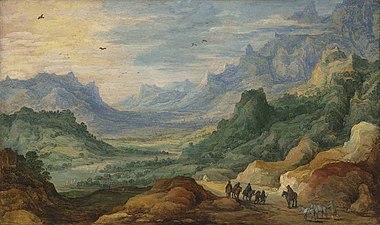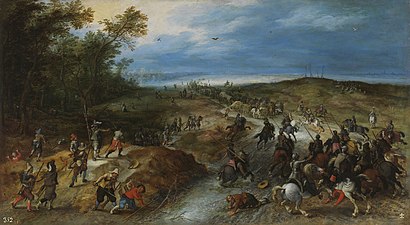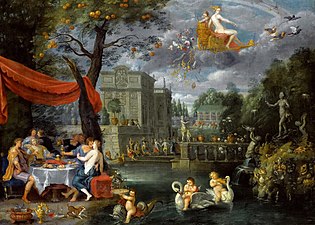Jan Brueghel the Younger

Jan Brueghel (also Bruegel or Breughel) the Younger (/ˈbrɔɪɡəl/,[1][2] also US: /ˈbruːɡəl/;[3][4] Dutch: [ˈjɑn ˈbrøːɣəl] ⓘ; 13 September 1601 – 1 September 1678) was a Flemish Baroque painter. He was the son of Jan Brueghel the Elder, and grandson of Pieter Bruegel the Elder, both prominent painters who contributed respectively to the development of Renaissance and Baroque painting in the Southern Netherlands. Taking over his father's workshop at an early age, he painted the same subjects as his father in a style which was similar to that of his father. He regularly collaborated with leading Flemish painters of his time.[5]
Life

Brueghel was born in Antwerp on 13 September 1601 as the son of Jan Brueghel the Elder and Isabella de Jode. His mother was the daughter of the cartographer, engraver and publisher Gerard de Jode. He trained and collaborated with his father in his workshop.[6] His father was a friend and close collaborator of Peter Paul Rubens. Brueghel likely assisted with his father's large-scale commissions.[7]
On the wishes of his father he traveled around 1622 to Milan where he was welcomed by Cardinal Federico Borromeo.[8] The cardinal was a patron and friend of his father who had met in Rome about 30 years earlier.[6] In what was likely an act of rebellion against his father, he went to Genoa where he stayed with his cousins, the Antwerp painters and art dealers Lucas de Wael and Cornelis de Wael. Their mother was a sister of Brueghel's mother. At the time his friend and fellow Antwerp artist Anthony van Dyck was also active in Genoa. He later worked in Valletta on Malta in 1623. From 1624 to 1625 he also resided in Palermo on Sicily at the time when van Dyck was also working there.[9]
Brueghel learned that his father had died on 13 January 1625 from cholera only after his return to Northern Italy in Turin. Wanting to return to Antwerp immediately, he had to delay his departure for 16 days due to a severe fever. After recovering from his illness, he set off for his homeland by way of France. In Paris he met the Antwerp art dealer and painter Peter Goetkint the Younger, who was the son of Peter Goetkint the Elder, the master of Jan's father. Goetkint was eager to return to Antwerp because his wife was expected to deliver a baby soon. The child was born on 25 August, the day on which Breughel arrived in Antwerp with his traveling companion who himself died a few days later.[6]

Brueghel took over the management of his father's workshop, sold the finished works of his father and finished some of his father's unfinished paintings after completing them.[8] In the Guild year 1624-1625, Brueghel became a master painter of the Guild of Saint Luke of Antwerp.[10]
In 1626 he married Anna Maria Janssens, daughter of Abraham Janssens, a prominent history painter in Antwerp.[9] He continued to operate the large workshop of his father. He became dean of the Guild of Saint Luke in 1630. That same year he was commissioned by the French court to paint a series of paintings on the life of Adam.[11] It seems that his studio declined after this period and that he started to paint smaller scale paintings which commanded lower prices than those produced earlier.[8]
In later years, he worked independently in Paris in the 1650s and produced paintings for the Austrian court in 1651. He is recorded again in Antwerp in 1657 where he remained until his death.[8]
His pupils included his older sons Abraham, Philips and Jan Peeter, his nephew Jan van Kessel, and his younger brother Ambrosius.[9]
Work

General
Taking over his father's workshop at an early age, he painted the same subjects as his father in a style which was similar to that of his father. His repertoire included history paintings, allegorical and mythological scenes, landscapes and seascapes, hunting pieces, village scenes, battle scenes and scenes of hellfire and the underworld. Unlike his father, he did not paint as many flower still lifes, and put more emphasis on painting animals in landscapes.[9][8] After the death of his father he changed his signature from 'Brueghel' to 'Breughel'.[9] About 340 paintings have been attributed to him. While he did not surpass his father in the quality of his output, his early works can hardly be distinguished from those of his father in terms of their high level of execution.[8]
Landscapes

He painted a wide variety of landscapes including: landscapes of woods, rivers and harbours, villages, cityscapes, architectural views with figures, veduti, hell scenes, landscapes with the Holy Family, paradise landscapes and allegorical landscapes. These landscapes show his father's influence although he would develop some personal touches in his later career.[8] His best works are his wide landscapes, which he produced on his own or in collaboration with other painters such as Hendrick van Balen the Elder and Joos de Momper.[7] During his career, he collaborated with many other artists such as Jan van Balen the Younger - the son of his father's collaborator Hendrick van Balen the Elder -, Pieter de Lierner, Adriaen Stalbemt, Lucas Van Uden, his brother-in-law David Teniers the Younger, his father-in-law Abraham Janssens, Sebastiaen Vrancx, Denijs van Alsloot and Hendrik de Clerck.[8]
In view of the strong demand for large decorative landscapes at the time, Brueghel would sometimes have his father's works copied in his workshop and then sell them under his father's signature.[5] In the wide landscapes he often reprised compositions of his father but executed them in a different palette.[8] Among his veduta paintings can be counted a The Royal Palace in Brussels (c. 1627) executed in collaboration with Sebastiaen Vrancx.[8]
In his village landscapes Brueghel initially followed his father's precedent and gradually developed his own idiom in the 1640s.[8]
-
A Mountainous Landscape with Travelers (with Joos de Momper); early 17th-century, oil on panel, 45 × 75 cm, private collection.
-
River Landscape with Windmills; after 1616, oil on panel, 44 × 66 cm, private collection.
-
Assault on a Convoy (with Sebastiaen Vrancx); 1620–25, oil on panel, 48 × 86 cm, Museo del Prado.
-
Snowy Landscape; after 1625, oil, 45 × 76 cm, Museo del Prado.
-
Allegory of the World; 1625, oil, 66 × 91 cm, private collection.
-
Rest on the Flight into Egypt; after 1626, oil on oak wood, 61 × 83 cm, Kunsthistorisches Museum.
-
Aeneas and the Sibyl in the Underworld; 1630s, oil on copper, 27 x 36 cm, Metropolitan Museum of Art.
Still lifes
A less prolific flower painter than his father, he was inspired by his father's works on which he produced his variations. His flower pieces are usually executed on a smaller scale and are less compact, slimmer and less detailed.[8]
His father had created the new still life category of garland paintings, a special type of still life developed in Antwerp along with other artists such as Hendrick van Balen, Frans Francken the Younger, Peter Paul Rubens and Daniel Seghers. These paintings typically show a flower garland around a devotional image or portrait. This genre was initially inspired by the cult of veneration and devotion to Mary prevalent at the Habsburg court (then the rulers over the Southern Netherlands) and in Antwerp generally.[12]
Brueghel also painted various garland paintings in collaboration with other artists. They show the influence of Daniel Seghers.[8] An example is The Virgin and Child in a Cartouche with Flowers painted in collaboration with the figure painter Pieter van Avont in the 1640s.[13]
Family tree
| |||||||||||||||||||||||||||||||||||||||||||||||||||||||||||||||||||||||||||||||||||||||||||||||||||||||||||||||||||||||||||||||||||||||||||||||||||||||||||||||||||||||||||||||||||||||||||||||||||||||||||||||||||||||||||||||||||||||||||||||||||||||||||||||||||||||||||
|
| |||||||||||||||||||||||||||||||||||||||||||||||||||||||||||||||||||||||||||||||||||||||||||||||||||||||||||||||||||||||||||||||||||||||||||||||||||||||||||||||||||||||||||||||||||||||||||||||||||||||||||||||||||||||||||||||||||||||||||||||||||||||||||||||||||||||||||
References
- ^ "Brueghel". Collins English Dictionary. HarperCollins. Retrieved 10 August 2019.
- ^ "Bruegel". Lexico UK English Dictionary. Oxford University Press. Archived from the original on 22 March 2020.
- ^ "Brueghel". The American Heritage Dictionary of the English Language (5th ed.). HarperCollins. Retrieved 10 August 2019.
- ^ "Brueghel". Merriam-Webster.com Dictionary. Retrieved 10 August 2019.
- ^ a b Jan Brueghel the Younger at the Getty Center
- ^ a b c Frans Jozef Peter Van den Branden, Geschiedenis der Antwerpsche schilderschool, Antwerpen, 1883, pp. 444–455 (in Dutch)
- ^ a b Anne T. Woollett and Ariane van Suchtelen; with contributions by Tiarna Doherty, Mark Leonard, and Jørgen Wadum, Rubens and Brueghel: A Working Friendship, 2006, pp. 5–33
- ^ a b c d e f g h i j k l m Hans J. Van Miegroet, Jan Brueghel the younger, Oxford Art Online, accessed 21 February 2022
- ^ a b c d e Jan Brueghel (II) record on the website of the Netherlands Institute for Art History
- ^ Ph. Rombouts and Th. van Lerius (ed.), De liggeren en andere historische archieven der Antwerpsche sint Lucasgilde Volume 2, Antwerp, Julius de Koninck, 1871, pp. 631, 641, 654, 656, 669, 671 (in Dutch)
- ^ Johnny Van Haeften, Dutch and Flemish Old Master Paintings, Johnny Van Haeften gallery, 2005, p. 11
- ^ Ursula Härting, Review of Susan Merriam, Seventeenth-Century Flemish Garland Paintings. Still Life, Vision and the Devotional Image
- ^ Jan Brueghel the Younger Pieter van Avont, The Virgin and Child in a Cartouche with Flowers at Lempertz
External links
 Media related to Jan Brueghel the Younger at Wikimedia Commons
Media related to Jan Brueghel the Younger at Wikimedia Commons










